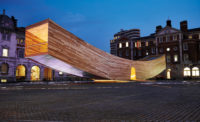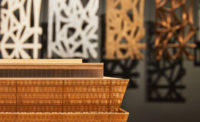The Victoria & Albert Museum is the nucleus of the London Design Festival, the nine-day city-wide program that grows in scale and scope every year. Within the V&A itself, a suite of specially commissioned temporary installations is equally diverse and dispersed, colonizing far-flung corners of the sprawling building and interacting with permanent displays to cast new light on the museum’s architecture and collections.
“Liquid Marble,” by French designer Mathieu Lehanneur, presents a contemporary essay in ornament and material richness amid the gilded carvings and pale wood panelling of an eighteenth-century music room. Four panels of black marble are set like a low table in the center of the space, whose polished surface has been carved into aqueous ripples recreating 3D scans of ocean waves. Artificial candlelight sparkles on the dark surface like whitecaps on a stormy sea.
Reflected light also gives life to “Foil,” which extends 65 feet through the dimly-lit tapestry gallery. Created by British designer Benjamin Hubert, it comprises 50,000 mirror-finish stainless steel panels set on an undulating, motor-driven ribbon that is in constant motion. Illumination from LEDs bounces from this fluid surface to create ever-changing patterns on the walls and ceiling.
Two other exhibits – “Beloved” and “The Green Room” – occupy the museum’s circulation routes. “Beloved,” by Istanbul-based Tabanlıoğlu Architects, reinterprets the 1943 Turkish novel Madonna in a Fur Coat, recently published for the first time in English. Its location on a bridge spanning the medieval and renaissance galleries alludes to the story’s setting between two cities, Berlin and Ankara. Narrow cracks in the faces of a 42-feet-long mirrored box reveal fragments from the narrative, recreated in a multi-sensory variety of media, from physical objects to text and sound.
The “Green Room” is a kinetic installation by London-based studio Glithero and occupies the full height of a six-story stairwell at one of the museum’s secondary entrances. Sponsored by a watchmaker, it functions as an abstract timepiece but is most effective in drawing attention to architectural details that visitors hurrying towards the galleries might otherwise overlook. A cylindrical curtain of 160 multi-colored cords drops through the space, topped by a cam arm whose slow rotations cause the trailing tendrils to rise and fall sequentially over the space of a minute, and sends delicate shivers through their length. Splashes of daylight strike the cords in bursts of iridescent color, drawing the eye up through the space to take in its high round windows, classical stonework and lofty dome.
While the installations featured at this year’s Festival are smaller and less overtly spectacular than the highlights of previous editions, they share a subtle sophistication, and are an eloquent and engaging demonstration design’s ability to refresh or reframe our environments.
London Design Festival at the Victoria & Albert Museum is on view through September 25.














